In the history of physics, 1905 was called the "Einstein Year of Miracles". Einstein was born in this year and published five epoch-making papers in succession, which established the position of the greatest physicist of the 20th century. But Einstein became a household name, and it would not be until 14 years later, in 1919, a century from now.
In this year, Einstein experienced three major events: divorced his college classmate Mileva; remarried her cousin Elsa; and became popular all over the world overnight. If you must give a name to 1919, then it is called "Einstein divorce remarriage and adulthood."

Einstein at the Berlin Institute in 1919
divorce
On February 14, 1919, the first Valentine's Day after the end of World War I, Einstein and his wife Mileva finally formally divorced.
They had separated 4 years ago. Einstein was director of an institute of physics in Berlin, Germany; Mileva was in Zurich, Switzerland, with their two sons.
Einstein's change of attitude towards Mileva is very suitable to use a line to describe: "When I was watching the moon with me, I was called Xiaotiantian. Now the newcomer is better than the old one, and he is called Madam Niu.

Einstein and first wife Mileva
The two were classmates in physics. Mileva was three years older than Einstein. They had a sibling relationship when they were sophomores. Mileva will take care of Einstein, who is not sloppy, and can discuss mathematical physics with him-every male and female student in science and technology hopes to meet such girls. Three years after graduation, Einstein and Mileva got married and also became a patent office staff member that year.
As everyone knows, in the days of the patent office, Einstein published several papers on quantum and relativity, showing amazing physics talent. But his marriage life was not so smooth: Mileva wanted to break out of the male-dominated academic world, but after the marriage, she lived a trivial housewife-style life. On the one hand, Einstein devoted his energy to scientific research and communication, and rarely cared about family life.
Can't live any longer? Divorce it.

The once happy Einsteins
The child's problem is very easy to solve: Einstein, who can not take care of himself, takes two sons, which is impossible in this life. In this way, the issue of divorce was finally reduced to the issue of money.
In order to persuade Mileva to divorce, Einstein raised her living expenses from 6,000 to 9,000 (at the time, 1 mark could buy 2 dozen eggs), and made an amazing promise: if she won the Nobel Prize Will transfer a prize of up to 225,000 marks to Mileva.

Einstein's 1922 Nobel Prize in Physics certificate he finally fulfilled his promise
Mileva initially strongly opposed divorce, but during the negotiations, she had been tortured by anxiety and depression for too long, and her youngest son was admitted to a nursing home due to illness. She had a difficult life and finally decided to accept Einstein's huge compensation.
Soon after the two parties reached an agreement, the Zurich District Court formally issued a divorce verdict.
The reason for the divorce in the judgment is as follows: Einstein "admittedly maintained a close relationship with a cousin in Berlin for 4 and a half years. Therefore, the plaintiff's divorce request due to the other party's personal communication should be immediately determined to be legal." For this reason, under Swiss law, Einstein was eventually ordered to ban remarriage for two years-although he soon violated the sentence.

Einstein and Elsa divorce certificate

Einstein admits collusion with cousin in divorce certificate
Get married again
remarry
On June 2, 1919, four months after Einstein's first marriage ended, he married the cousin Elsa mentioned in the judgment.
Einstein and this Elsa have known each other since they were young, but they didn't become secretly affective until 1912 (7 years before the divorce). At that time Einstein was busy giving lectures throughout Europe, and Mileva at home became more depressed. Marital life was overshadowed, and Einstein decided to go to Berlin on vacation alone. Coincidentally, Einstein met Elsa, who had been divorced for 4 years and had two daughters.

Einstein and second wife Elsa
The difference between Mileva and Elsa is too big: Mileva was born in Serbia, Elsa is a German native; Mileva looks more melancholic, Elsa looks better; Mileva is proficient in mathematical physics, Elsa knows nothing about this; Mileva is naturally taciturn, and Elsa is a lively and cheerful person, very passionate about socializing.
Elsa was mature and considerate. Her enthusiasm caused Einstein to forget his wife at home, and Einstein soon fell. Nevertheless, after the holiday, out of love and guilt for the children, Einstein offered to put an end to this extramarital affair.

Einstein's breakup letter to Elsa
In a letter announcing the breakup with Elsa, Einstein included the address of his new office. Two years later, Elsa sent a birthday card to this address, and Einstein immediately wrote back. Not long after, Einstein accepted the invitation of physicist Planck as a new academician of the Prussian Academy of Sciences, a director of a new institute, and a professor at the University of Berlin, based in Berlin, where Elsa is located.
You know, at this time Einstein's tags were: the youngest academician of Prussia (he was only 34 years old at the time), a professor at the University of Berlin, a separation from his wife, and an extramarital affair with his cousin-thanks for the lack of Weibo at that time.

Einstein (second from left) and Planck (center) at the party. This photo vividly proves that physicists don't believe in hair.
Later, Einstein, who was working hard, suffered from severe chronic gastritis. Elsa found a house in her apartment building and helped him move in, so that he could more easily take care of this lack of life. Self-care genius cousin. The relationship between the two people's near cohabitation began.
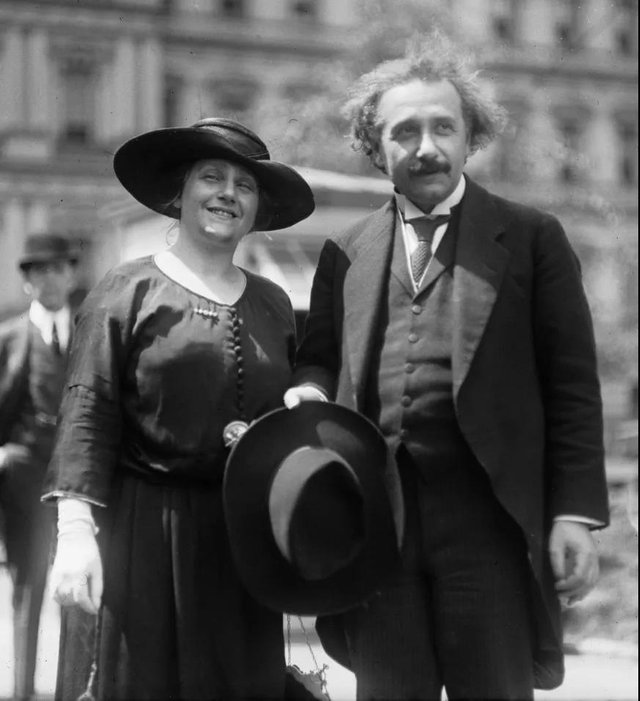
1921 Einstein's and Elsa's marriage in New York continued until Elsa's death
Both Einstein and Elsa have experienced failed marriages and have long lost their passion. Their union is more like a cooperation. Elsa did not understand the theory of relativity at all, and did not exchange ideas with Einstein, but she was both a wife and a mother, helping him with housework and managing his money. Elsa was willing to provide these services, partly because of her admiration for the talented cousin, and partly because she enjoyed the reputation that Einstein brought.
After divorce and remarriage, in 1919 there were still major events waiting for Einstein.
Become famous
In May 1919, on the eve of a total solar eclipse, the British sent two expeditions, one to a small island in West Africa and the other to the Amazon forest. What the expedition will observe is a star cluster at the edge of the sun-during the total solar eclipse, the star cluster will become even brighter. That night, they took pictures of these stars again, and started to wash and calculate on the island.
The two expeditions tested Einstein's theory by shooting starlight: Gravity bends light. In Einstein's prediction, the light from the star cluster photographed by the expedition will be deflected by 1.7 arc seconds near the sun, while Newton, who has ruled physics for hundreds of years, gives a result of 0.85 arc seconds.
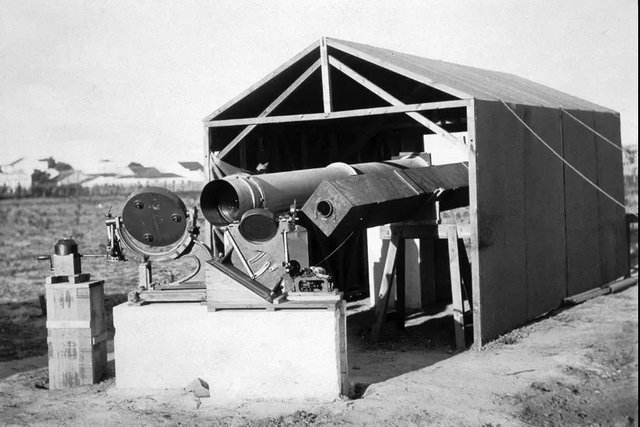
Telescope for total solar eclipse observation in 1919
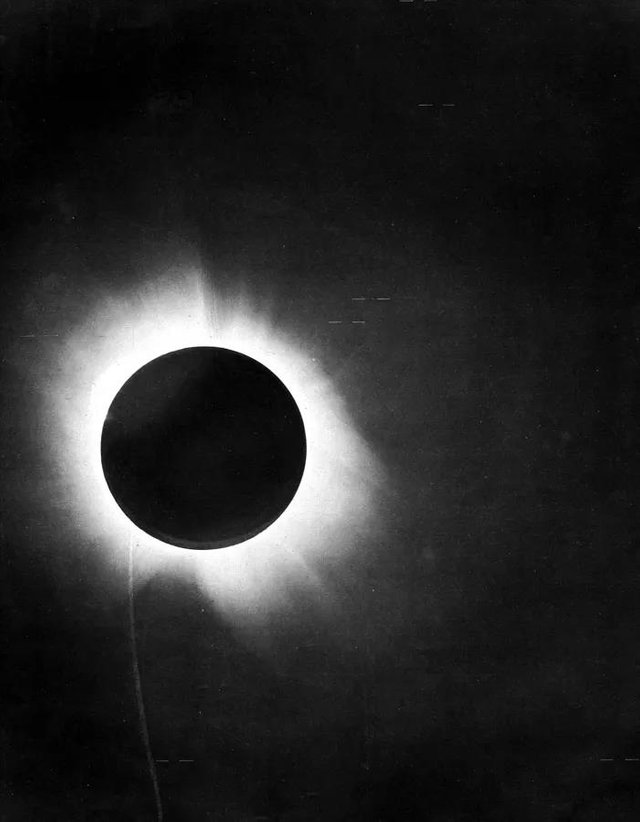
Total solar eclipse observed by the expedition
On November 6, the Burlington Hall in London was crowded, and members of the Royal Society gathered to await the final report on the eclipse observation. The final observations were announced: a little more than 1.7 arc seconds. Astronomer Dyson announced at the meeting: "After serious research on the negatives, I solemnly declare that they have unquestionably confirmed Einstein's prediction."
The Royal Society President Thomson's summary is more concise and powerful: "This result is one of the greatest achievements of human thought."
A few days later, Einstein, who was staying in Berlin, learned of the news from the telegram. To celebrate the experimental verification of his theory, he bought a new violin to reward himself.
But the public is not so calm. On the second day after the report, the Times published a three-line headline: "Revolution in Science, New Cosmic Theory, and Newtonian Thought Overturned". The New York Times used six rows of headlines in an article: "The light of heaven is skewed" and "Einstein's theory triumphed."
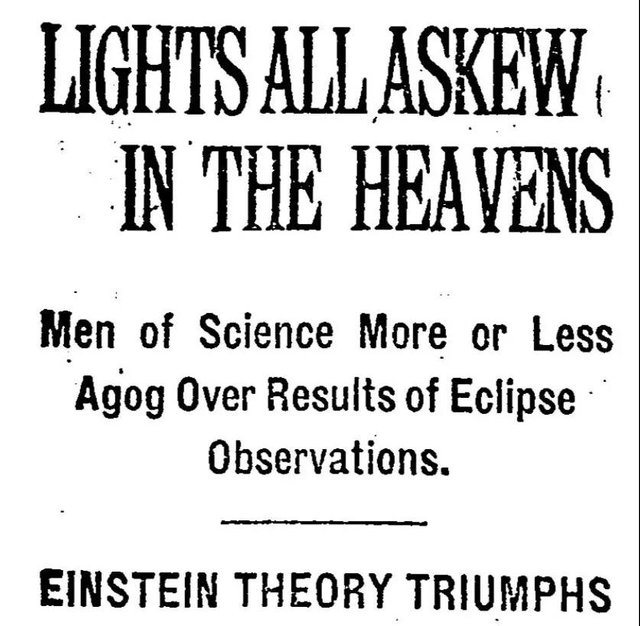
Six New York Times headlines on total solar eclipse in 1919
Under the influence of the newspaper, the ordinary people became extremely excited. They were told that Newton's theory had been overturned, the space around the planet was curved, and things were relative (though they themselves did not quite understand what it meant).
Einstein's popular book "A Brief Introduction to Special and General Relativity" quickly became a bestseller and was republished. All lectures and lectures related to relativity were packed, and even the most common coachmen and shop assistants were debating whether relativity was correct.
The human universe was overturned by this Jew called Einstein.
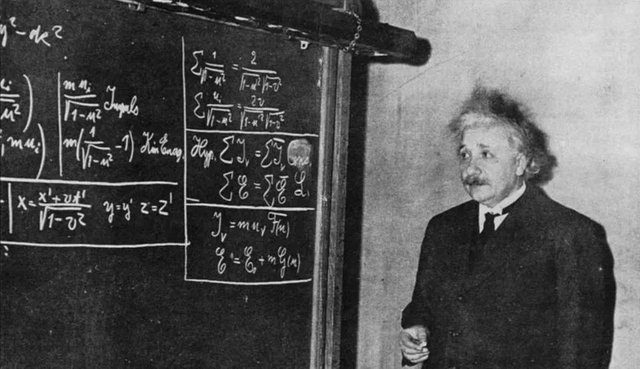
Einstein explained the theory of relativity to the audience in 1934. He frequently attended various occasions to explain his theory after he became famous.
In the face of sudden popularity, Einstein, who is accustomed to low-key life, often showed resentment. In the face of the pursuit of the media, he said that he was "almost out of breath, let alone taking time to do any valuable work." However, Einstein said so, but the actual action was very honest. He was often interviewed by newspapers and was willing to socialize with various celebrities (such as attending the premiere of Chaplin's films).
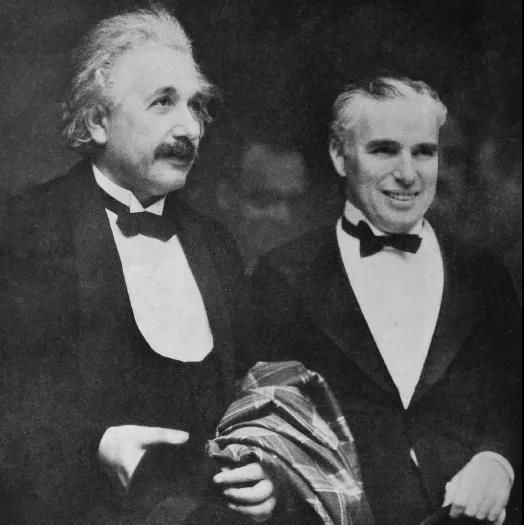
In 1931, Einstein took a photo with Chaplin in Hollywood
Einstein's popularity overnight was also related to the historical background of the time. In 1919, just after the end of World War I, people's traumatized hearts needed healing. These abstract concepts of space, time, and universe make people temporarily forget about war and shift their attention to a new theory that subverts traditional cognition: a raisin contains the energy to destroy a city, and a person changes when approaching the speed of light It's so short ... Scientific discoveries like this are too satisfying for human curiosity.
But becoming famous overnight is not without its disadvantages. Unlike the now publicized social media, people in the last century had an instinctual rejection of fame. Most of Einstein's friends and colleagues felt that the propaganda of relativity was too high-profile. Einstein's Jewish identity has also been repeatedly mentioned. His theory has been labeled "Jewish physics" and has been condemned by German nationalists, who believe that his theory of relativity represents moral "relativity".

1919 was a year after the end of the First World War. The people of the world have not recovered from the shadow of war.
In any case, Einstein's 1919 ended in fame and criticism. This year was not the most important year of his life: 1905, when his dissertation broke out, and 1939, when he proposed to study the atomic bomb, both left deeper memories in human history. But after experiencing divorce, remarriage, and overnight fame, it seems no exaggeration to call 1919 his most weird year.
end
Finally, it is worth mentioning that in addition to Einstein, in 1919, a German began to take the stage of history.
Just two months before the results of the total solar eclipse were announced, a German military officer swore to join a party called the German Workers' Party, and his speech talent and nationalist tendencies impressed party leaders. The man then wrote a statement in a letter, the first time he had expressed a similar point in writing:
"The ultimate goal of the German government is to completely wipe out Jews from this world."
The officer was Adolf Hitler. After a few years, Einstein will make a final farewell to his hometown Germany because of this demon.
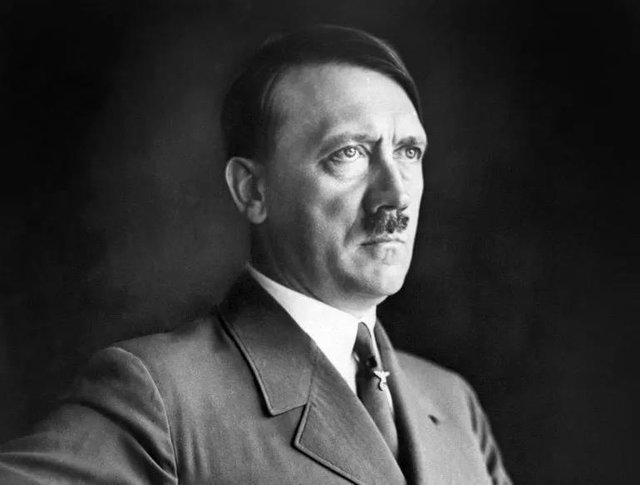
Adolf Hitler, the most notorious demon of the 20th century